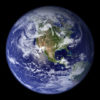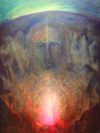A Prayer for One’s Country
Prayer for One’s Country (adapted)
–Adam Bittleston
O Christ, Thou knowest
The souls and spirits
Whose deeds have woven
This land’s destiny.
May we who today
Are bearers of this destiny
Find the strength and the light
Of thy servant Michael.
And our hearts be warmed
By Thy blessing, O Christ,
That our deeds may serve
Thy work of world healing.
This appears as a “Prayer for Britain” in the 1966 edition of Meditative Prayers for Today by Adam Bittleston. It does not appear in the current edition, available at http://shop.steinerbooks.org/Title/9781782504672 . This much-loved collection can be used as a kind of breviary. From the description:
Growing into the daily use of these meditative prayers makes us conscious of how we stand in great world rhythms. We learn to follow the alternation of waking and sleeping, the ordering of the seven days of the week, and the course of the seasons, as gifts of heavenly powers gradually become known to us.
This is a small, elegant guide to aid meditation.
C O N T E N T S:
Introduction
PRAYERS:
Evening and morning
The week
The year
Earth
Against fear
For one who has died
Intercessory prayers
For children
The guardian angel
Blessing on a house
For a journey
For the peoples of the world
Grace before meals
Thanksgiving
A note about the Lord’s Prayer
This appears as a “Prayer for Britain” in the 1966 edition of Meditative Prayers for Today by Adam Bittleston. It does not appear in the current edition, available at http://shop.steinerbooks.org/Title/9781782504672 . This much-loved collection can be used as a kind of breviary. From the description:
Growing into the daily use of these meditative prayers makes us conscious of how we stand in great world rhythms. We learn to follow the alternation of waking and sleeping, the ordering of the seven days of the week, and the course of the seasons, as gifts of heavenly powers gradually become known to us.
This is a small, elegant guide to aid meditation.
C O N T E N T S:
Introduction
PRAYERS:
Evening and morning
The week
The year
Earth
Against fear
For one who has died
Intercessory prayers
For children
The guardian angel
Blessing on a house
For a journey
For the peoples of the world
Grace before meals
Thanksgiving
A note about the Lord’s Prayer
–Rev. Cindy Hindes




